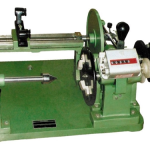Introduction to Coils in Electrical Applications
Coils are fundamental components in electrical applications, consisting of numerous wire loops or turns around a core. This core can be made from various materials, including metals, plastics, ceramics, fiber, or glass. However, for our focus on electrical coils, we will consider only metal cores. Coils are made from wires of excellent electrical conductors like copper or aluminum, and sometimes even precious metals like silver, gold, or platinum, due to their superior conductivity. The core material often used includes Cold Rolled Grain Oriented (CRGO) or Cold Rolled Non-Grain Oriented (CRNGO) steel, and ferrite materials, which have advantageous properties at high frequencies. Thus, the essential components of a coil are the wire, the core, and the coil winder machine used for its manufacture.
Importance of Coil Winders
Coil winders are crucial for winding coils, an essential part of any product that operates with electrical power. The primary function of a coil winder is to apply wire loops evenly around the core. The reliability and quality of the coil significantly depend on the precision of the coil winder. There are three basic types of coil winders: single-axis winders, two-axis coil winders, and three or more-axis automated coil winding equipment.
Single-Axis Coil Winder

Single-axis coil winders, also known as manual coil winders, are the simplest type. In these machines, only the spindle rotates, while the wire is spread over the core within a defined area. This spreading can either be unguided or guided manually. When unguided, the wire builds up naturally, falling into less built-up areas of the core, resulting in a random but complete winding. Manually guided winding, although still random, tends to be better controlled. The significant downside of single-axis winders is the poor quality of the coils produced, as the potential difference between wire loops can be high, leading to coil failure or burning. However, these machines are the cheapest option. Below is an image of a manual coil winder, which consists of a hand-driven spindle and a counter to count the wire loops.
Two-Axis Coil Winder
Two-axis coil winders include a spindle mechanism, like the single-axis winder, and an additional wire spreading or traverse mechanism. These winders address the shortcomings of single-axis winders by ensuring the even spreading of wire loops within a defined space. This even spreading minimizes potential differences between loops, reducing the risk of coil burnout. The traverse unit can be mechanically or electronically interfaced with the spindle mechanism. Below is an image of a manual two-axis coil winder, followed by an image of an electronically interfaced traverse movement for a coil winder.

You can watch a video demonstrating a two-axis coil winder with an electronically interfaced traverse unit here: E300 Winding Machine (youtube.com)
The interfacing of the traverse unit and the advantages of two-axis coil winders will be discussed in further detail in later sections. Acme Mechatronics, Inc., a leading manufacturer in the USA, offers over 25 models of two-axis coil winders with electronically controlled and programmable features, capable of winding various types of coils within the machine’s capabilities.
Three-Axis Coil Winder

Three-axis coil winders are electronically controlled machines that include a spindle mechanism, a traverse mechanism, and a third axis for additional operations before or after the wire looping process. These winders are more expensive and are typically used in high-volume production settings due to their advanced capabilities.
Conclusion:
Coil winders are indispensable in the production of high-quality electrical coils. Understanding the different types of coil winders—single-axis, two-axis, and three-axis—helps in choosing the right equipment based on the specific requirements of the coils being produced. Acme Mechatronics, Inc. stands out as a notable manufacturer, offering a range of advanced, electronically controlled coil winders, coil winding machines that ensure precision and reliability in coil winding processes.
For further information and a complete range of products, visit Acme Mechatronics, Inc.’s website. https://acmemechatronics.com

